Juniper jn0-682 practice test
Data Center, Professional Exam
Last exam update: Jul 20 ,2024
Question 1
You are asked to scale the available bandwidth within your Clos data center network to support more
east-west traffic. In this scenario, what are two ways to accomplish this task? (Choose two.)
- A. Add leaf devices to increase available paths and bandwidth
- B. Use aggregated interfaces in the fabric.
- C. Add spines to increase available paths and bandwidth.
- D. Interconnect all spines to increase available paths and bandwidth.
Answer:
BD
Question 2
You are deploying an EBGP IP fabric. In this scenario, which statement is true?
- A. Each spine should peer with every other spine using physical addresses.
- B. Each spine should peer with each leaf using loopback addresses.
- C. Each spine should peer with every other spine using loopback addresses.
- D. Each spine should peer with each leaf using physical addresses.
Answer:
A
Question 3
You are deploying a 3-stage Clos IP fabric in your data center. In this scenario, which statement is
correct?
- A. Each server-facing interface on a leaf node is always three hops away from other server-facing interfaces.
- B. Each spine node must be physically connected to all other spine nodes.
- C. There is an eight-spine node limitation.
- D. No direct physical connections exist between leaf nodes.
Answer:
A
Question 4
Which two statements about ZTP are true? (Choose two.)
- A. The image storage service and the DHCP server can be running on different server hosts.
- B. When a switch is booted. DHCP requests are sent only through the management Ethernet interface.
- C. The image storage service must be running on the same server host where the DHCP service is running.
- D. When a switch is booted, DHCP requests are sent through the management interface as well as attached revenue ports.
Answer:
AB
Question 5
You are building an IP fabric underlay for your data center. You are asked to ensure that the two spine
devices are in the same AS (65000) while the six leaf devices are in a different AS (65512).
In this scenario, which two statements are correct by default? (Choose two.)
- A. All BGP routes advertised by a leaf device will be accepted on the spine devices.
- B. A leaf device will accept all BGP routes received from the spine that were originated from another leaf device.
- C. All BGP routes advertised by a leaf device will be rejected on the spine devices.
- D. A leaf device will reject all BGP routes received from the spine that were originated from another leaf device.
Answer:
AB
Question 6
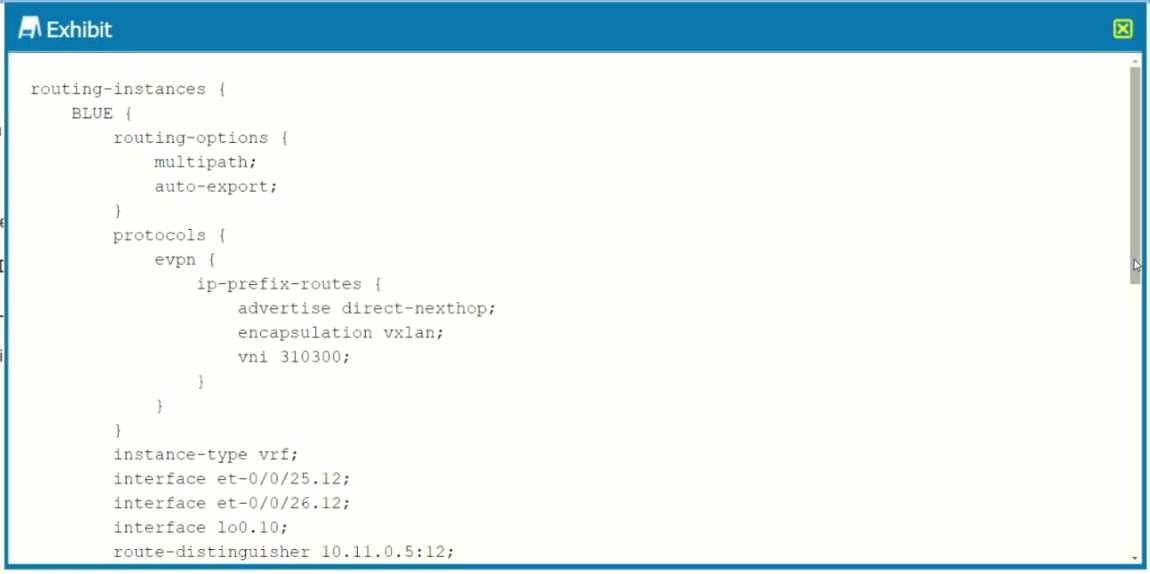
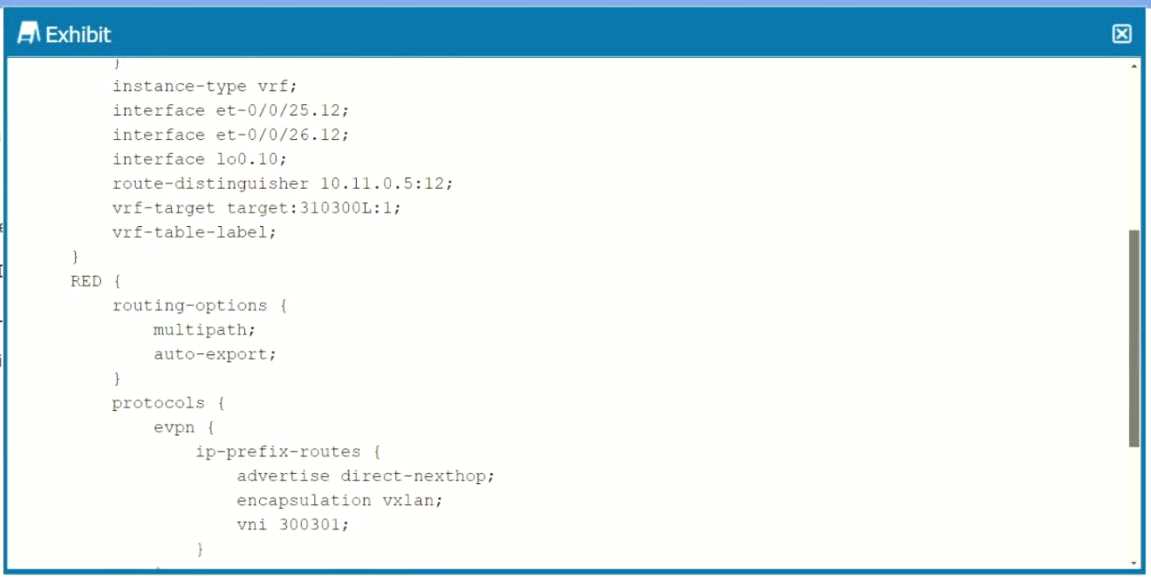
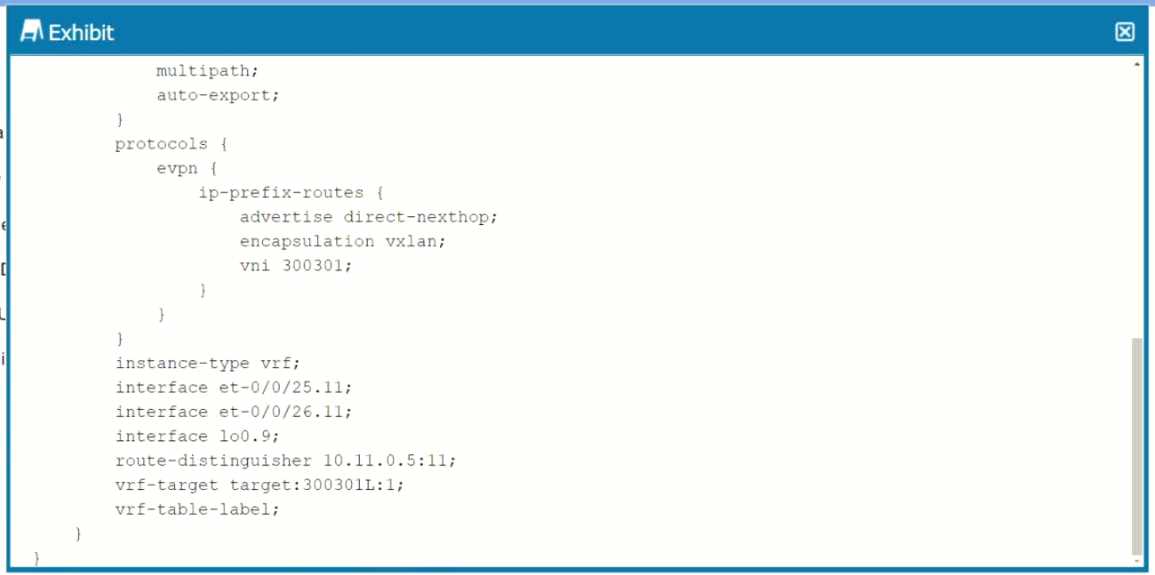
You have deployed a multitenant EVPN-VXLAN fabric. You must have the routes in the BLUE VRF
show up in the RED VRF. In this scenario, how would you achieve this goal?
- A. Configure a VRF export policy on the BLUE VRF that matches the RED VRF route target.
- B. Configure the RED route target in the BLUE VRF.
- C. Configure the BLUE route target in the RED VRF.
- D. Configure a VRF import policy on the RED VRF that matches the BLUE VRF route target.
Answer:
D
Question 7
Exhibit.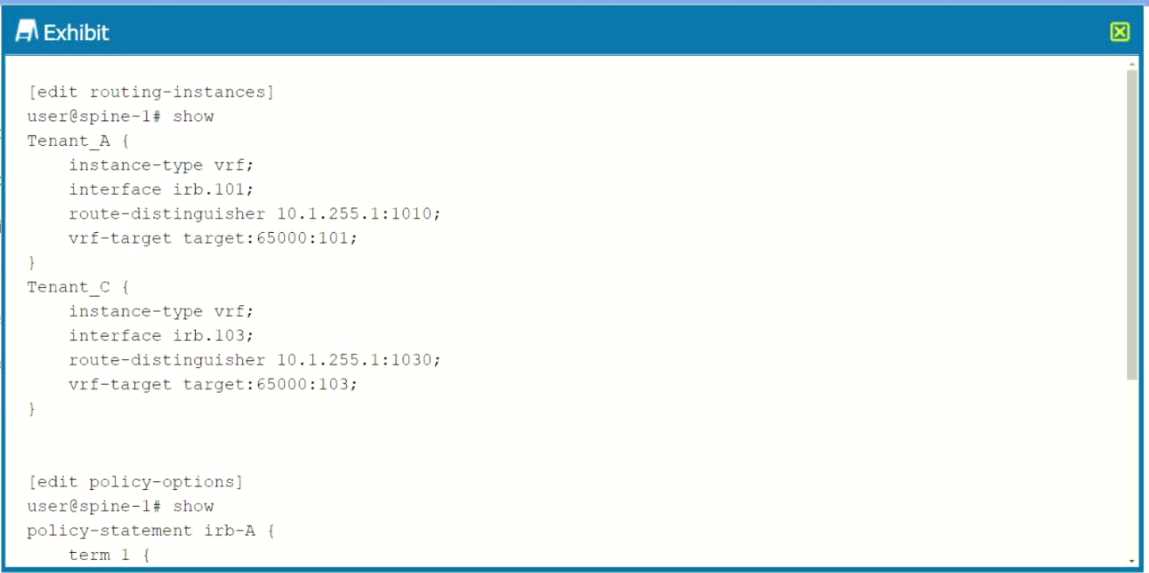
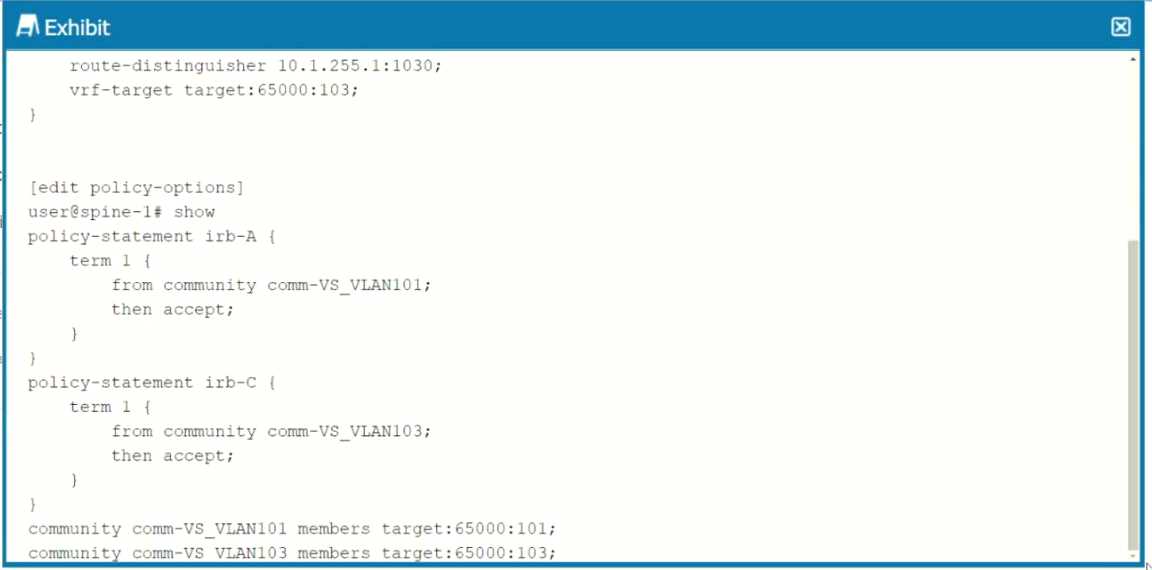
Referring to the exhibit, you want to advertise the IRB routes between both routing instances.
Which two configuration parameters would be applied to accomplish this task? (Choose two.)
- A. Apply policy irb-A under instance Tenant_c and apply policy irb-c under instance Tenant_A as import policies.
- B. Configure auto-export under both routing instances.
- C. Configure vrf-table-label under both routing instances.
- D. Apply policy irb-A under instance Tenant A and apply policy irb-c under instance Tenant_c as export policies.
Answer:
AC
Question 8
Which two statements are true about VRF routing instances? (Choose two.)
- A. VRF can be used in conjunction with Layer 3 logical interfaces.
- B. Each logical Layer 3 interface can belong to only one routing instance.
- C. Each logical Layer 3 interface can belong to multiple routing instances.
- D. VRF does not enable multitenancy.
Answer:
AB
Question 9
You want to enable an EBGP-based IP fabric to allow ECMP routes to be populated into the RIB. In
this scenario, which action will accomplish this task?
- A. Enable the forwarding-options ecmp-do-local-lookup parameter.
- B. Enable the multipath multiple-as BGP parameter.
- C. Enable the routing-options multipath global parameter.
- D. Enable the chassis ecmp-alb parameter.
Answer:
B
Question 10
A customer wants to connect two data centers on different subnets using EVPN. What are two
implications of using different IP subnets at each site? (Choose two.)
- A. Using different IP subnets at each site allows Layer 3 gateways to exchange only type-3 routes.
- B. MAC addresses will need to be advertised between the data centers.
- C. MAC addresses will not need to be advertised between the data centers.
- D. Using different IP subnets at each site allows Layer 3 gateways to exchange only type-5 routes.
Answer:
CD
Question 11
Exhibit.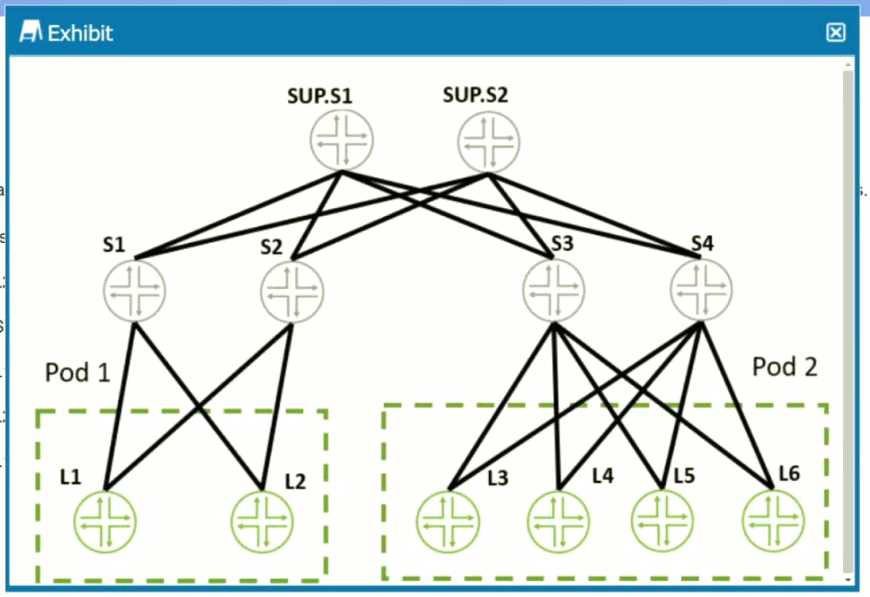
Referring to the exhibit, you have a data center with two PODs. Seamless EVPN-VXLAN stitching is
used to facilitate communication between the PODs.
Which three statements are true in this scenario? (Choose three.)
- A. AVXLAN tunnel can form between L2 and S1.
- B. A VXLAN tunnel can form between S1 and S2.
- C. AVXLAN tunnel can form between L1 and L2.
- D. AVXLAN tunnel can form between L2 and S3.
- E. AVXLAN tunnel can form between L1 and L4.
Answer:
ABD
Question 12
You are considering deploying a MAC-VRF type routing instance with a VLAN-bundle service type. In
this scenario, which two statements are correct? (Choose two.)
- A. It can be implemented in a bridge overlay architecture.
- B. VLAN normalization is supported.
- C. Multiple VLAN IDs per EVI are supported.
- D. It can be implemented in an ERB architecture.
Answer:
AC
Question 13
What are two types of EVPN routes? (Choose two.)
- A. ES-lmport route target
- B. Ethernet segment
- C. MAC mobility
- D. MAC advertisement
Answer:
BD
Question 14
When considering VRF routing-instances for network segmentation, which two statements are true?
(Choose two.)
- A. A logical interface can participate in multiple VRFs.
- B. Multiple VRFs on a single device consolidate routing information to a single table.
- C. VRFs have independent routing tables.
- D. VRFs support overlapping subnets.
Answer:
CD
Question 15
You are asked to build a single export policy that can be applied to all devices to advertise only
loopback IP addresses in the 172.16.0.0/24 subnet into your EBGP IP fabric. In this scenario, which
two solutions would accomplish this task? (Choose two.)
A)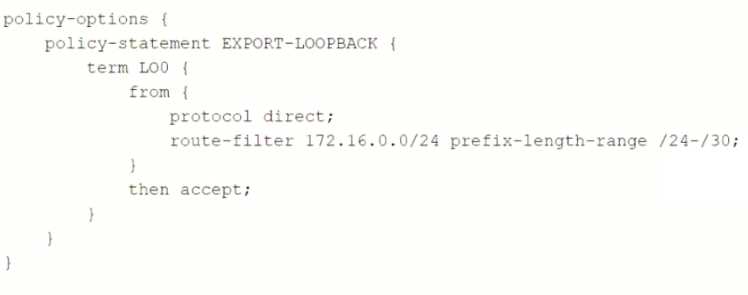
B)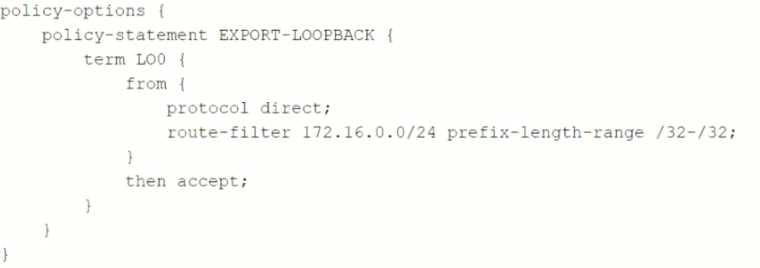
C)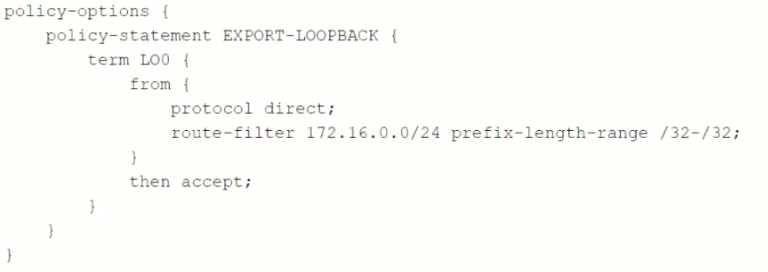
D)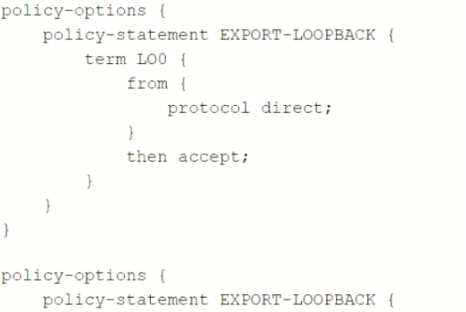
- A. Option A
- B. Option B
- C. Option C
- D. Option D
Answer:
B